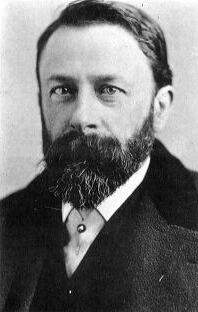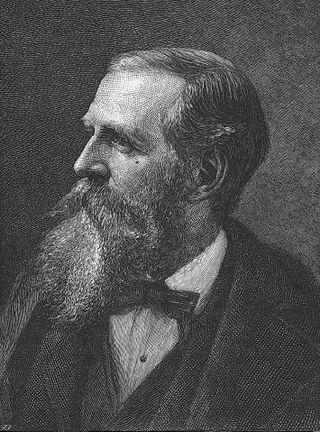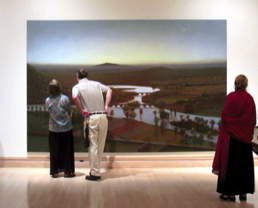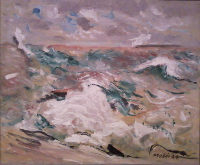
Jan Josephszoon van Goyen was a Dutch landscape painter. The scope of his landscape subjects was very broad as he painted forest landscapes, marine paintings, river landscapes, beach scenes, winter landscapes, cityscapes, architectural views and landscapes with peasants. The list of painters he influenced is much longer. He was an extremely prolific artist who left approximately twelve hundred paintings and more than one thousand drawings.

En plein air, or plein-air painting, is the act of painting outdoors.

George Inness was a prominent American landscape painter.

Frederic Edwin Church was an American landscape painter born in Hartford, Connecticut. He was a central figure in the Hudson River School of American landscape painters, best known for painting large landscapes, often depicting mountains, waterfalls, and sunsets. Church's paintings put an emphasis on realistic detail, dramatic light, and panoramic views. He debuted some of his major works in single-painting exhibitions to a paying and often enthralled audience in New York City. In his prime, he was one of the most famous painters in the United States.

Albert Bierstadt was a German American painter best known for his lavish, sweeping landscapes of the American West. He joined several journeys of the Westward Expansion to paint the scenes. He was not the first artist to record the sites, but he was the foremost painter of them for the remainder of the 19th century.

The Hudson River School was a mid-19th-century American art movement embodied by a group of landscape painters whose aesthetic vision was influenced by Romanticism. Early on, the paintings typically depicted the Hudson River Valley and the surrounding area, including the Catskill, Adirondack, and White Mountains.

John Frederick Kensett was an American landscape painter and engraver born in Cheshire, Connecticut. He was a member of the second generation of the Hudson River School of artists. Kensett's signature works are landscape paintings of New England and New York State, whose clear light and serene surfaces celebrate transcendental qualities of nature, and are associated with Luminism. Kensett's early work owed much to the influence of Thomas Cole, but was from the outset distinguished by a preference for cooler colors and an interest in less dramatic topography, favoring restraint in both palette and composition. The work of Kensett's maturity features tranquil scenery depicted with a spare geometry, culminating in series of paintings in which coastal promontories are balanced against glass-smooth water. He was a founder of the Metropolitan Museum of Art.

Fitz Henry Lane was an American painter and printmaker of a style that would later be called Luminism, for its use of pervasive light.

Martin Johnson Heade was an American painter known for his salt marsh landscapes, seascapes, and depictions of tropical birds, as well as lotus blossoms and other still lifes. His painting style and subject matter, while derived from the romanticism of the time, are regarded by art historians as a significant departure from those of his peers.

Robert Swain Gifford was an American landscape painter. He was influenced by the Barbizon school and became a member of the Society of American Artists.

Luminism is an American landscape painting style of the 1850s to 1870s, characterized by effects of light in landscape, through the use of aerial perspective and the concealment of visible brushstrokes. Luminist landscapes emphasize tranquility, and often depict calm, reflective water and a soft, hazy sky. Artists who were most central to the development of the luminist style include Fitz Hugh Lane, Martin Johnson Heade, Sanford Gifford, and John F. Kensett. Painters with a less clear affiliation include Frederic Edwin Church, Jasper Cropsey, Albert Bierstadt, Worthington Whittredge, Raymond Dabb Yelland, Alfred Thompson Bricher, James Augustus Suydam, and David Johnson. Some precursor artists are George Harvey and Robert Salmon. Joseph Rusling Meeker also worked in the style.

White Mountain art is the body of work created during the 19th century by over four hundred artists who painted landscape scenes of the White Mountains of New Hampshire in order to promote the region and, consequently, sell their works of art.

Stephen W. Hannock is an American painter known for his atmospheric landscapes––compositions of flooded rivers, nocturnes and large vistas––which often incorporate text inscriptions that relate to family, friends or events of daily life. The artist is known for creating a unique luminosity using a signature technique that involves building up layers of paint on the canvas, sandpaper-polishing it, applying new layers of paint and polishing again. Some of his work is thought to be inspired by the Hudson River School.

Bathers at Asnières is an 1884 oil on canvas painting by French artist Georges Pierre Seurat, the first of his two masterpieces on the monumental scale. The canvas is of a suburban, placid Parisian riverside scene. Isolated figures, with their clothes piled sculpturally on the riverbank, together with trees, austere boundary walls and buildings, and the River Seine are presented in a formal layout. A combination of complex brushstroke techniques and a meticulous application of contemporary color theory bring to the composition a sense of gentle vibrancy and timelessness.

Alfred Thompson Bricher was an American painter associated with White Mountain art and the Hudson River School.

Edmund Darch Lewis was an American landscape painter known for his prolific style and marine oils and watercolors. Lewis was born in Philadelphia, Pennsylvania, in a well-to-do family. He started training at age 15 with German-born Paul Weber (1823–1916) of the Hudson River School. At age 19 he exhibited at the Pennsylvania Academy of the Fine Arts, and was elected an Associate of the Academy at age 24.

Hurricane is a 1944 oil painting by American artist John Marin, located in the Indianapolis Museum of Art, which is in Indianapolis, Indiana. He used quick brushstrokes and thickly daubed paint to depict a turbulent ocean such as he experienced near his summer home in Maine.

William R. Sullivan was an American painter, printmaker and publisher.

Twilight in the Wilderness is an 1860 oil painting by American painter Frederic Edwin Church. The woodlands of the northeastern United States are shown against a setting sun that intensely colors the dramatic altocumulus clouds. Church scholar John K. Howat describes the painting as "one of his finest ever" and as "the single most impressive example of Church's depictions of unsullied North American woodlands and their most famous representation in nineteenth-century painting".

Francis Augustus Silva was an American Luminist painter of the Hudson River School. His specialty was marine scenes, particularly of the Atlantic coast, a genre in which he masterfully captured the subtle gradations of light in the coastal atmosphere. He focused on romantic scenes, avoiding depictions of seaside recreation, even when painting scenes at Coney Island, which was then already a popular recreational area.




















